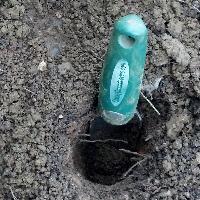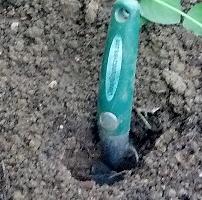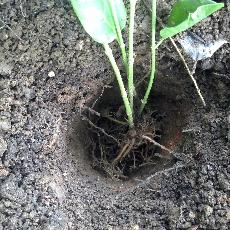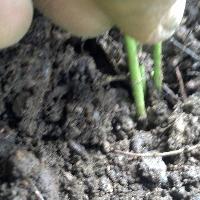How To Plant
This article describes how to plant
bare root plants, but the same basic strategy works for all plants.
If you are planting potted plants, it is easier: omit step 5 ("LIFT").
The example below shows Vinca (we have a big sale on
Vinca minor plants, with free shipping), the strategy applies to all plants.
Make the hole wider and deeper than the root mass being planted (at least 10% larger, 50% larger is better, 100% larger is best).
This guide shows how to plant on a slope. If you are planting on level ground then of course there is no need to create berms - a curved mound of soil - to catch runoff.
If you want to improve the rate of establishment and spread, get some manure, compost, or other organic material to mix into the soil that you put under and around your plants (see below).
Click images to see larger photos.
1. DIG
Dig a hole that is 2 times wider and deeper than the root mass. For example, a root 3 inches deep and 1 1/2 inches wide requires a hole 6 inches deep and 3 inches wide.
|

|
2. LOOSEN
Break up the soil at the bottom of the hole so the roots can grow downward more easily.
Optional: add some organic material such as manure or compost to the bottom of the hole.
|

|
3. PLANT
Set a plant in the hole. Plan ahead and leave room to collect rain water: the green stems should be about 1 inch below the level of the soil level, even more if you are on a slope.
|

|
4. FILL
Loosely drop in soil around the plant, fill the hole about 3/4 of the way.
Optional: fill with soil mixed 50/50 with some organic material such as manure or compost.
|

|
5. LIFT
Assuming that your plant does not have fragile stems, grip the base of the stems and lift up the plant approximately 1/2 an inch. Gently push the soil down around the edges of the hole to compact it slightly. Do not pack it hard, just enough to remove large pockets of air (where water could pool and freeze, possibly damaging the roots).
|

|
6. FORM BOWL
Add more soil if needed, forming a bowl around the base of the plant to collect water. These plants are on a slope, and the bowl should be perpendicular to gravity, so the bowl is mounded on the downhill side and cut deep on the uphill side. This collects runoff and the roots get more water.
|

|
That's all there is to it, it is not hard.
If you are planting in the fall, wait until spring to fertilize.
If you have a large area to plant, consider getting a
plant auger
.
to speed your planting chore
(see
Ground preparation and fertilizing for details on augers, soil amendment, etc.).
Check out the links below for information on other important topics that govern the success of your project: fertilizing, mulching, pH, etc.
See also:
Planting instructions
Ground preparation and fertilizing
Testing and adjusting the pH of your soil
Explanation and description of bare roots
When you should plant
 (0)
(0)




